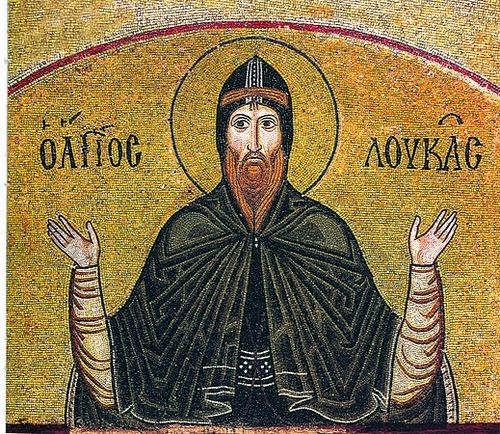Saint Luke of Hellas was a native of the Greek village of Kastorion. The son of poor farmers, the saint from childhood had toiled much, working in the fields and shepherding the sheep. He was very obedient to his parents and very temperate in eating. He often gave his own food and clothing to the poor, for which he suffered reproach from his parents. He once gave away almost all the seed which was needed for planting in the fields. The Lord rewarded him for his charity, and the harvest gathered was greater than ever before.
As a child, he prayed fervently and often. His mother saw him more than once standing not on the ground, but in the air while he prayed.
After the death of his father, he left his mother and went to Athens, where he entered a monastery. But through the prayers of his mother, who was very concerned about him, the Lord returned him to his parental home in a miraculous manner. He spent four months there, then with his mother’s blessing he went to a solitary place on a mountain called Ioannou (or Ioannitsa). Here there was a church dedicated to the holy Unmercenaries Cosmas and Damian, where he lived an ascetical life in constant prayer and fasting. He was tonsured there by some Elders who were on pilgrimage. After this, Saint Luke redoubled his ascetic efforts, for which the Lord granted him the gift of foresight.
After a seven years on Ioannou, the saint moved to Corinth because of an invasion of the Bulgarian armies. Hearing about the exploits of a certain stylite at Patras, he went to see him, and remained for ten years to serve the ascetic with humility and obedience. Afterwards, the saint returned again to his native land and again began to pursue asceticism on Mount Ioannou.
The throngs of people flocking there disturbed his quietude, so with the blessing of his Elder Theophylactus, Saint Luke went with his disciple to a still more remote place at Kalamion. After three years, he settled on the desolate and arid island of Ampelon because of an invasion of the Turks. Steiris was another place of his ascetic efforts. Here brethren gathered to the monk, and a small monastery grew up, the church of which was dedicated to the Great Martyr Barbara. Dwelling in the monastery, the saint performed many miracles, healing sicknesses of soul and of body.
Foreseeing his end, the saint confined himself in a cell and for three months prepared for his departure. When asked where he was to be buried, the monk replied, “Throw my body into a ravine to be eaten by wild beasts.” When the brethren begged him to change these instructions, he commanded them to bury his body on the spot where he lay. Raising his eyes to heaven, he said, “Into Thy hands, O Lord, I commend my spirit!”
Saint Luke fell asleep in the Lord on February 7, 946. Later, a church was built over his tomb. Myrrh flowed from his holy relics, and many healings occurred.

